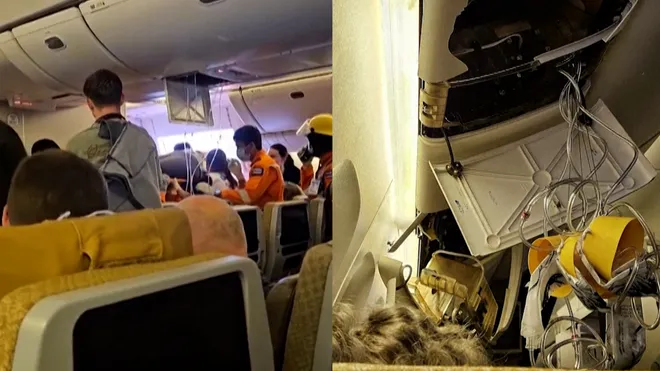
Passengers on Singapore Airlines flight SQ321 from London to Singapore were caught off guard by the turbulence that struck on Tuesday (May 21). Approximately three hours before reaching their destination, Malaysian student Dzafran Azmir noticed the Boeing 777-300R starting to tilt upwards and shake, signaling the onset of chaos.
The 28-year-old Dzafran Azmir braced himself and ensured his seatbelt was fastened. Unfortunately, many other passengers did not have their seatbelts on.
“Suddenly, there was a very dramatic drop, and everyone seated without a seatbelt was launched into the ceiling. Some hit their heads on the overhead baggage compartments, denting them, and others broke through the areas where lights and masks are located,” Azmir recounted to Reuters.
“People fell to the ground, my phone flew out of my hand and ended up a couple of aisles away, and shoes were flung about.”
Singapore Airlines reported that flight SQ321 encountered sudden extreme turbulence over the Irrawaddy Basin at 37,000 feet, approximately 10 hours after departure. The pilot declared an emergency and diverted the aircraft to Bangkok, where it landed safely at 3:45 PM local time.

Tragically, one passenger, a 73-year-old British man, died, and 30 others were injured, some critically. Photos posted online depicted the aftermath, with food trays and items strewn across the floor, oxygen masks dangling from the ceiling, and visible damage to parts of the plane’s interior.
Passenger Andrew Davies recounted that the seatbelt sign had been turned on moments before the sudden drop. “So many injured people, head lacerations, bleeding ears,” he wrote on X, noting that a female passenger was screaming in pain.
Belongings were scattered, and coffee and water were splattered on the ceiling. Despite the chaos, the cabin crew remained stoic and did everything they could, according to Davies. Passengers with medical training also stepped in to help as best they could.
“Anyone who is injured was not wearing a seatbelt,” Davies noted.
Azmir added that the crew and passengers in the lavatories were hurt the most. “We discovered people just on the ground, not able to get up. There were a lot of spinal and head injuries,” he told Reuters.
Aviation analysts told CNA that SQ321 likely encountered clear air turbulence (CAT), which is not detectable on a jet’s weather radar. Independent aviation analyst Alvin Lie explained, “Normally, for turbulence caused by movement of clouds, pilots will be alerted on the radar so they can avoid it or notify the crew and passengers to wear their seatbelts.”
“However, looking at the number of injuries, I believe that SQ321 encountered CAT, where a plane can be tossed about violently.”
Lie also noted that the turbulence likely struck after lunch, around the time when many passengers were queuing to use the toilet. “This is where injuries can happen,” he said.




